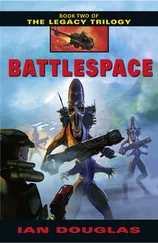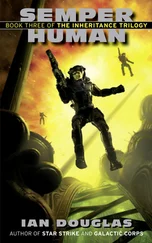Dra’ethde and Gru’mulkisch both had been carefully scanned, and their Sh’daar technoparasites identified. A scrambler had been designed and placed into the translator units they wore to block the receipt and transmission of any state secrets. In general, however, it was wiser simply not to discuss state secrets in their presence.
In any case, it was possible that a hotline to the Sh’daar might someday be useful.
“And your information in exchange?” Gru’mulkisch asked him.
“The Sh’daar have trouble dominating the galaxy,” Koenig said, “because the galaxy is far too large. Too many worlds, too many sapient species. Interstellar empires, as such, simply can’t exist . . . not when the amount of information needed to manage them is so vast. And that’s where we humans have an advantage. Interior lines of communication.”
“I do not understand your use of interior,” Gru’mulkisch said. “The Sh’daar do not surround you.”
Score, Koenig thought. Until that moment, the Earth Confederation had not been sure how extensive Sh’daar space was. Most contacts with their clients had been in toward the galactic core, in the constellations of Sagittarius, Ophiuchus, Libra, and others in that general direction.
Earth needs allies, Koenig thought to himself. Technic species not yet under the Sh’daar thrall. We just might find them in the opposite direction from the core. Orion, Taurus . . . out toward the rim.
“I meant the word figuratively,” Koenig told the Agletsch. “With a much smaller volume of space to defend, and fewer worlds with which we have to be concerned, we can move from one to another more quickly, react more quickly to a threat than can the Sh’daar, with their much larger domain. When we make a decision, when Fleet HQ gives an order, it can be disseminated among all of our forces and put into effect much more swiftly than is possible for the enemy.”
“Quite true,” Gru’mulkisch said. “Of course, you currently have the singular disadvantage of being . . . I believe one of your politicians called it ‘a house divided.’ ”
“The quote originally was from one of our sacred texts,” Koenig said. He tried to find a way to give a positive response, to turn it around and dismiss the implied threat, but could not. “And . . . no. You’re quite right.”
He looked away from the two aliens, letting his gaze drift across the glittering crowd of humans filling the plaza. Most were in formal attire—evening dress, diplomatic cloaks, designer gowns and dinner jackets. Numerous others were stylishly nude, some with luminous jewelry or skin adornment . . . or wearing holographic projections that flowed and rippled like liquid light. You would never guess, looking at that throng of civilians, that the nation currently was at war both with the unseen alien puppet masters dominating much of the galaxy and with other humans.
He turned back to the two Agletsch data traders. “You’re right . . . and we’re going to have to do something about that.”
Chapter Four
21 January 2425
Squadron Briefing Room
USNA CVS America
In transit
0950 hours, TFT
By now, Omega Centauri was far behind. America and her escorts had threaded their way through the TRGA cylinder at Omega Centauri—one of seven discovered so far in that star-packed volume of space—and emerged again at the original Sh’daar Node cylinder from which the acronym was taken . . . the Texaghu Resch Gravitational Anomaly.
“Funny name,” a young Starhawk driver with lieutenant’s rank tabs at his throat said. “ ‘Texaghu.’ Does that have anything to do with Texas?”
America’s fighter squadron pilots had been gathering on the carrier’s briefing-room deck for the past ten minutes, now, and the place was already pretty crowded.
“Nah,” Lieutenant Donald Gregory said. “But you’re new, right? Just came aboard a couple of months ago?”
“That’s right.” The pilot extended his hand and Gregory took it. “Lieutenant Jamis Anderson. Late of the great state of Texas, and now with the Merry Reapers.”
“Don Gregory.” He slapped the VFA-96 squadron patch on his shoulder. “Black Demons.” He turned to introduce the attractive woman with him. “And this here is Meg Connor.”
“Very pleased to meet you, ma’am,” Anderson said, a broad grin spreading across his face. “I downloaded your report about you and your run-in with the Slan!”
Connor, formerly of VFA-140, the Dracos, had been captured by the highly advanced alien Slan in an operation at 36 Ophiuchi two months ago, but been rescued by the Marines shortly after. Her observations of her captors had helped Naval Intelligence put together a strategy to deal with the va Sh’daar aliens . . . and led to Admiral Gray’s unexpected victory over them a few days later at 70 Ophiuchi. Since then, her own squadron lost in the Slan attack, she’d been transferred to the Black Demons.
“Texaghu Resch,” Gregory told him, “is Drukrhu—that’s the principal Agetsch trade pidgin—for a star originally catalogued by the Turusch, another Sh’daar client species. Means ‘the Eye of Resch.’ Actually, it’s a transliteration from the language of a species called the Chelk.”
“Never heard of ’em.”
“They’re extinct,” Connor told him. “Apparently, the star was seen as the eye of a mythic god or hero in their culture, a being called Resch.”
“And they’re extinct?”
Gregory nodded. Whoever or whatever Resch had been, he’d not been powerful enough to save the Chelk. Like Humankind, they’d chosen to fight the Sh’daar rather than have their technologies restricted. “Humans haven’t been there, but according to the Agletsch, the Chelk homeworld is now a lifeless, airless, glassed-over ball of charred and blasted rock. Seems like they didn’t get the Sh’daar memo about no technic singularities.”
“Damn . . .”
“It’s all written up in America’s archives,” Connor pointed out. “Interesting reading . . . and it helps you kind of stay focused on what we’re fighting for.”
“Better living through higher technology,” Anderson said, still grinning. The catchphrase was currently a popular one, and expression of North America’s determination to continue Humankind’s exponential increase in GRIN technologies.
“May I have your attention, please,” another voice said over the pilots’ in-head circuitry. They turned to face the front of the briefing room, where Captain Fletcher, America’s CAG, stood on a low stage. “Please grow your seats and link in. We have the visuals from the recon flyby yesterday.”
Chairs began emerging from the deck in neatly ordered rows, and the crowd—more than two hundred strong—began taking seats. America carried six fighter and strike squadrons, one recon squadron, and two search and rescues . . . fifteen hundred people if you included the support, intelligence, logistics, and maintenance personnel. But the meeting this morning had been called just for the pilots and flight officers—the pointed end of America’s very big and powerful stick.
With a rustle of motion and dwindling conversation, the crowd of men and women sat down and began linking in. The briefing would be carried out through America’s primary AI, and consisted of a download of information acquired by the recon squadron—VQ-7, the Sneaky Peaks. Commander James Henry Peak, who’d given his name to the group twenty-some years ago, had long since been promoted to captain, rotated Earthside to Naval Intelligence, and eventually retired, but his old squadron had kept the punning name. VQ-7’s current CO was Commander Thom McCabe, who was on the stage now with the CAG.
“Good morning,” McCabe said. “I’m sure you’re all eager to see the results of our close recon pass of the Black Rosette yesterday. What Lieutenant Walton saw was . . . interesting. . . .”
Читать дальше












